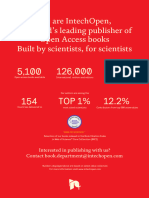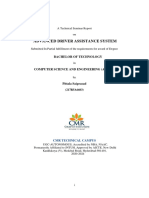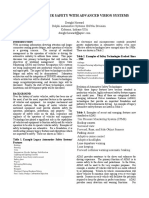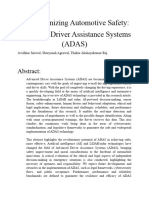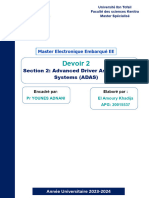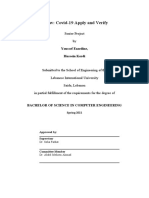ADAS Report
Uploaded by
sampansh91ADAS Report
Uploaded by
sampansh91ADAS
ABSTRACT
Over the last decade, the Advanced Driver Assistance System (ADAS) concept has evolved
significantly. ADAS involves several technologies such as automotive electronics, vehicle-to-
vehicle (V2V) vehicle-to-infrastructure (V2I) communication, RADAR, LIDAR, computer vision,
and machine learning. Of these, computer vision and machine learning based solutions have mainly
been effective that have allowed real-time vehicle control, driver aided systems, etc.
However, most of the existing works deal with the deployment of ADAS and autonomous driving
functionality in countries with well-disciplined lane traffic. Nevertheless, these solutions and
frameworks do not work in countries and cities with less-disciplined/chaotic traffic. This paper
identifies the research gaps, reviews the state-of-the-art looking at the different functionalities of
ADAS and its levels of autonomy. Importantly, it provides a detailed description of vision
intelligence and computational intelligence for ADAS.
The eye-gaze and head pose estimation in vision intelligence is detailed. Notably, the learning
algorithms such as supervised, unsupervised, reinforcement learning and deep learning solutions
for ADAS are considered and discussed. Significantly, this would enable developing a real-time
recommendation system for system-assisted/autonomous vehicular environments with less-
disciplined road traffic
Dept of Computer Science, JCET 2023-2024 1
ADAS
Chapter 1
INTRODUCTION
In today’s world, technology is constantly evolving and making our lives easier. One area where
these advancements have made significant progress is in the automotive industry. Enter Advanced
Driver-Assistance Systems (ADAS), the futuristic technology that promises to automate driving.
Imagine a car that not only alerts you to potential hazards but also takes actions to prevent accidents.
That’s exactly what ADAS does. From lane departure warnings and automatic braking to adaptive
cruise control and blind spot detection, this technology enhances driver safety and assists in avoiding
collisions.
ADAS uses a network of sensors, cameras, and radars to monitor the vehicle’s surroundings and
gather real-time data. This data is then analyzed to provide valuable insights to the driver, helping
them make better-informed decisions on the road.
With autonomous vehicles on the horizon, ADAS is becoming increasingly common in new vehicles.
It not only improves the driving experience but also serves as a stepping stone towards a future of
fully autonomous transportation.
In this article, we’ll explore the ins and outs of ADAS, its various components, and the benefits it
brings to the table. So buckle up and get ready to dive into the world of cutting-edge automotive
technology.
DAS full form stands for Advanced Driver Assistance Systems. It’s a suite of electronic functions
designed to improve safety of the driver, the passenger and the pedestrian. The aim is to first
minimise and then altogether eliminate accidents on the road.
A simple sensor that beeps near an object, or a car that allows hands off parking, are all levels of
ADAS, that are currently taking on some of the drivers’ responsibilities. This is leading to what one
hopes is a completely autonomous car which requires no driver input whatsoever.
Advanced driver assistance systems (ADAS) can be defined as digital technologies that help drivers
in routine navigation and parking without fully automating the entire process but instead leveraging
computer networks to enable more data-driven and safer driving experiences.
Dept of Computer Science, JCET 2023-2024 2
ADAS
Advanced driver-assistance systems (ADAS) are technical elements that improve car safety.
According to LogisFleet, when correctly built, these devices leverage a human-machine interface to
increase the driver’s potential to adapt to road hazards. These devices improve safety and response
times to possible threats through early warning and automated systems.
Some of these systems are integrated into automobiles as standard parts, while manufacturers can
add aftermarket elements and even entire systems afterward to customize the vehicle for the
operator. Nearly all automobile collisions are caused by human error. One may prevent this by
employing modern driver aid technologies (ADAS).
ADAS aims to minimize the incidence and severity of automotive accidents that one cannot avert to
prevent deaths and injuries. These devices can give important data about traffic, road closures and
blockages, congestion levels, advised routes to avoid traffic, etc. One can also use such systems to
detect human driver weariness and distraction and issue cautionary signals to analyze driving
performance and offer recommendations.
These devices may take over control from humans on identifying danger, performing simple tasks
(like cruise control), or challenging maneuvers (like overtaking and parking).
Nowadays, most automobiles come equipped with standard safety features. Lane departure warning
systems or blind-spot warning systems, which use microcontrollers, sensors, and surveillance
systems to send signals of reflected items ahead, to the side, and the back of the car, could be familiar
to you. Technological advancements and the proliferation of automation measures have contributed
significantly to the popularity of car safety mechanisms. The following are a few examples of
available systems:
• Adaptive cruise control (ACC)
• Anti-lock braking systems
• Forward collision alert
• High beam protection system
• Lane departure alert
• Traffic lights traction control recognition
Dept of Computer Science, JCET 2023-2024 3
ADAS
These ADAS features rely on either a single front camera or a front stereovision camera. On
occasion, camera data is supplemented with information from other devices, such as light detection
and ranging (LIDAR) or radio detection and range (RADAR).
ADAS cameras are mounted inside the vehicle by the front windshield, behind the central rear-view
mirror. To maintain cleanliness of the glass in front of the camera, the ADAS camera’s field of view
is situated in the wiper area. RADAR sensing, visual sensing, and data fusion are sometimes coupled
in a single component.
The success of ADAS implementations depends on life-saving tools, including the most recent
interface standards and executing several algorithms to enable vision co-processing, real-time
multimedia, and sensor fusion subsystems.
The umbrella under which ADAS dwells has become more prominent as the accompanying ADAS
technologies are developed and polished, and vehicle makers try to appeal to consumers with an
extended range of safety- and convenience-focused functions.
Fig 1.1: Importance of ADAS
Dept of Computer Science, JCET 2023-2024 4
ADAS
The components of ADAS
ADAS is a complex system that relies on various components working together seamlessly. These
components include sensors, cameras, radars, and control units. Let’s take a closer look at each of
them.
Sensors:
Sensors play a crucial role in ADAS by constantly monitoring the vehicle’s surroundings. They can
detect objects, measure distances, and identify potential hazards. The most common types of sensors
used in ADAS are ultrasonic sensors, LiDAR (Light Detection and Ranging) sensors, and radar
sensors. Ultrasonic sensors are typically used for parking assistance, while LiDAR and radar sensors
are used for more advanced features like adaptive cruise control and collision avoidance.
Cameras:
Cameras in ADAS provide a visual representation of the vehicle’s surroundings. They can detect
lane markings, traffic signs, pedestrians, and other vehicles. The information captured by the cameras
is then processed by the control unit to make decisions and provide alerts to the driver. High-
resolution cameras are essential for accurate object detection and identification.
Radars:
Radars in ADAS use radio waves to detect the distance, speed, and direction of objects around the
vehicle. They are particularly useful in situations where visibility is poor, such as fog or heavy rain.
Radar sensors can detect objects that are not visible to the naked eye, making them an important
component of ADAS for collision avoidance and blind spot detection.
Control Units:
Control units act as the brain of the ADAS system. They receive data from sensors and cameras,
process it, and make decisions based on predefined algorithms. These decisions can range from
issuing warnings to taking control of certain vehicle functions to prevent accidents. Control units are
responsible for coordinating the actions of various ADAS components to ensure a safe driving
experience.
Dept of Computer Science, JCET 2023-2024 5
ADAS
Chapter 2
SYSTEM ARCHITECTURE
We put an array of advanced electronic sensors in the vehicles that first supplement the drivers eyes,
ears and inputs while ultimately taking over his duties. ADAS cars come equipped with RADAR,
SONAR, LiDAR and Geo location satellites to do everything for you. An onboard computer filters
all information from these sources in the blink of an eye and acts decisively compared to a human
who might take crucial milliseconds too long to react, leading to an avoidable accident.
Fig 2.1: System Architecture of ADAS
Dept of Computer Science, JCET 2023-2024 6
ADAS
ADAS works by constantly monitoring the vehicle’s surroundings and analyzing the data collected
by its sensors and cameras. This data is then processed by the control unit, which uses sophisticated
algorithms to detect potential hazards and make decisions to enhance driver safety.
When a potential hazard is identified, ADAS can provide different levels of assistance. For example,
if the system detects that the vehicle is drifting out of its lane, it can issue an audible or visual
warning to alert the driver. In more advanced ADAS systems, the control unit can even take control
of the steering to keep the vehicle within its lane.
Another common feature of ADAS is automatic emergency braking. If the system detects an
imminent collision with another vehicle or pedestrian, it can automatically apply the brakes to avoid
or mitigate the impact. This feature has proven to be highly effective in preventing accidents and
reducing the severity of collisions.
Adaptive cruise control is another popular feature of ADAS. It uses sensors and radars to maintain a
safe distance from the vehicle ahead. If the vehicle in front slows down or comes to a stop, the
ADAS system will automatically adjust the speed of the vehicle to maintain a safe following
distance.
The system architecture of Advanced Driver Assistance Systems (ADAS) typically involves a
combination of hardware and software components working together to provide various
functionalities aimed at enhancing vehicle safety and driving experience. Here's a simplified
overview of the typical architecture:
1. Sensors: ADAS relies on various types of sensors to gather data about the vehicle's surroundings.
These sensors include:
- Cameras: Provide visual information about the road, traffic signs, lane markings, pedestrians,
and other vehicles.
- Radar: Detect objects around the vehicle, including their distance, speed, and direction of
movement.
- Lidar: Measures distances using laser pulses, providing precise 3D mapping of the environment.
- Ultrasonic sensors: Detect nearby objects, particularly useful for parking assistance and obstacle
detection at low speeds.
Dept of Computer Science, JCET 2023-2024 7
ADAS
2. Sensor Fusion: Data from multiple sensors are fused together to create a comprehensive
understanding of the vehicle's surroundings. Sensor fusion algorithms integrate and process this data
to improve accuracy and reliability, providing a more robust perception of the environment.
3. Processing Unit: A powerful onboard computer or Electronic Control Unit (ECU) processes the
sensor data and runs various algorithms to interpret the information and make decisions in real-time.
This processing unit typically consists of:
- **Central Processing Unit (CPU)**: Executes software algorithms for sensor fusion, object
detection, decision-making, and control.
- **Graphics Processing Unit (GPU)**: Accelerates processing tasks related to image and video
data from cameras.
- **Application-Specific Integrated Circuits (ASICs)** or **Field-Programmable Gate Arrays
(FPGAs)**: Specialized hardware for specific processing tasks, such as neural network inference for
AI-driven features.
4. **Software Stack**: ADAS software encompasses a wide range of functionalities, including:
- **Object Detection and Classification**: Algorithms identify and classify objects in the
environment, such as vehicles, pedestrians, cyclists, and road signs.
- **Lane Detection and Tracking**: Detects lane boundaries and tracks the vehicle's position
within the lane.
- **Collision Avoidance**: Analyzes sensor data to detect potential collisions and trigger warnings
or autonomous braking interventions.
- **Adaptive Cruise Control (ACC)**: Maintains a safe distance from vehicles ahead by
automatically adjusting the vehicle's speed.
- **Lane-Keeping Assistance (LKA)**: Assists the driver in keeping the vehicle within its lane by
providing steering interventions or warnings.
- **Parking Assistance**: Helps the driver maneuver the vehicle into parking spaces through
automated steering and braking.
5. **Human-Machine Interface (HMI)**: Interfaces with the driver through visual, auditory, and
haptic feedback to convey information and warnings generated by the ADAS system. This may
include dashboard displays, heads-up displays (HUDs), audible alerts, and vibrating steering wheels
or seats.
Dept of Computer Science, JCET 2023-2024 8
ADAS
6. **Communication Interfaces**: ADAS systems may interface with external systems or
networks for various purposes, such as:
- **V2X Communication**: Exchanging data with other vehicles, infrastructure, and traffic
management systems for cooperative driving and safety applications.
- **Cloud Connectivity**: Accessing real-time traffic, weather, and mapping data for enhanced
situational awareness and route planning.
7. **Safety and Redundancy Mechanisms**: ADAS architectures incorporate redundant systems
and fail-safe mechanisms to ensure safe operation under various conditions. This may include
redundant sensors, backup power supplies, and fail-operational strategies to maintain critical
functionalities in the event of component failure.
Overall, the architecture of ADAS systems is complex and dynamic, continually evolving to
incorporate advancements in sensor technology, processing capabilities, and AI-driven algorithms.
The integration of these components enables ADAS to provide a wide range of driver assistance
features aimed at improving safety, convenience, and overall driving experience.
Dept of Computer Science, JCET 2023-2024 9
ADAS
Chapter 3
TECHNOLOGY USED
The components of ADAS
ADAS is a complex system that relies on various components working together seamlessly. These
components include sensors, cameras, radars, and control units. Let’s take a closer look at each of
them.
Sensors:
Sensors play a crucial role in ADAS by constantly monitoring the vehicle’s surroundings. They can
detect objects, measure distances, and identify potential hazards. The most common types of sensors
used in ADAS are ultrasonic sensors, LiDAR (Light Detection and Ranging) sensors, and radar
sensors. Ultrasonic sensors are typically used for parking assistance, while LiDAR and radar sensors
are used for more advanced features like adaptive cruise control and collision avoidance.
Cameras:
Cameras in ADAS provide a visual representation of the vehicle’s surroundings. They can detect
lane markings, traffic signs, pedestrians, and other vehicles. The information captured by the cameras
is then processed by the control unit to make decisions and provide alerts to the driver. High-
resolution cameras are essential for accurate object detection and identification.
Radars:
Radars in ADAS use radio waves to detect the distance, speed, and direction of objects around the
vehicle. They are particularly useful in situations where visibility is poor, such as fog or heavy rain.
Radar sensors can detect objects that are not visible to the naked eye, making them an important
component of ADAS for collision avoidance and blind spot detection.
Control Units:
Control units act as the brain of the ADAS system. They receive data from sensors and cameras,
process it, and make decisions based on predefined algorithms. These decisions can range from
issuing warnings to taking control of certain vehicle functions to prevent accident.
Dept of Computer Science, JCET 2023-2024 10
ADAS
Chapter 4
IMPLEMENTATION
Fig 4.1: Implementation Of ADAS
ADAS works by constantly monitoring the vehicle’s surroundings and analyzing the data collected
by its sensors and cameras. This data is then processed by the control unit, which uses sophisticated
algorithms to detect potential hazards and make decisions to enhance driver safety.
When a potential hazard is identified, ADAS can provide different levels of assistance. For example,
if the system detects that the vehicle is drifting out of its lane, it can issue an audible or visual
warning to alert the driver. In more advanced ADAS systems, the control unit can even take control
of the steering to keep the vehicle within its lane.
Another common feature of ADAS is automatic emergency braking. If the system detects an
imminent collision with another vehicle or pedestrian, it can automatically apply the brakes to avoid
Dept of Computer Science, JCET 2023-2024 11
ADAS
or mitigate the impact. This feature has proven to be highly effective in preventing accidents and
reducing the severity of collisions.
Adaptive cruise control is another popular feature of ADAS. It uses sensors and radars to maintain a
safe distance from the vehicle ahead. If the vehicle in front slows down or comes to a stop, the
ADAS system will automatically adjust the speed of the vehicle to maintain a safe following
distance.
4.1 The benefits of using ADAS
ADAS brings numerous benefits to both drivers and society as a whole. Let’s take a closer look at
some of the key advantages of using ADAS technology.
Improved Safety
The primary benefit of ADAS is improved safety on the road. By providing real-time alerts and
assistance, ADAS helps drivers avoid potential accidents and reduce the risk of injuries and fatalities.
The advanced features of ADAS, such as automatic emergency braking and lane departure warnings,
act as an extra pair of eyes on the road, enhancing driver awareness and responsiveness.
Enhanced Convenience
ADAS technology also offers enhanced convenience for drivers. Features like adaptive cruise control
and parking assistance make driving less stressful and more enjoyable. Adaptive cruise control, for
instance, reduces driver fatigue by automatically adjusting the vehicle’s speed to maintain a safe
distance from the vehicle ahead. Parking assistance helps drivers navigate tight parking spaces with
ease, reducing the chances of accidental bumps and scratches.
Environmental Benefits
ADAS can also contribute to a greener environment. By optimizing driving behaviors and reducing
the risk of accidents, ADAS helps improve fuel efficiency and reduce emissions. With the increasing
focus on sustainability, ADAS can play a significant role in achieving a more eco-friendly
transportation system.
Insurance Premium Reduction
Dept of Computer Science, JCET 2023-2024 12
ADAS
Many insurance companies offer discounts on premiums for vehicles equipped with ADAS
technology. The improved safety features of ADAS reduce the likelihood of accidents, making these
vehicles less risky to insure. By investing in ADAS, drivers can not only enhance their safety but
also enjoy potential cost savings on insurance premiums.
Transition to Autonomous Vehicles
ADAS serves as a stepping stone towards the adoption of fully autonomous vehicles. The technology
and infrastructure developed for ADAS can be leveraged to further progress autonomous driving
capabilities. By gradually introducing ADAS features, drivers can become more comfortable with the
idea of autonomous vehicles, leading to a smoother transition in the future.
4.2 Challenges and limitations of ADAS
While ADAS offers numerous benefits, it also comes with its fair share of challenges and limitations.
Let’s explore some of the key obstacles that need to be addressed for widespread adoption of ADAS
technology.
System Reliability
One of the main challenges of ADAS is ensuring the reliability and accuracy of the system. ADAS
heavily relies on sensors and cameras to gather data and make decisions. Therefore, any malfunction
or error in these components can lead to false alarms or incorrect actions, compromising the overall
safety of the system. Extensive testing, regular maintenance, and continuous improvement are
necessary to address this challenge.
User Education and Awareness
Another challenge is user education and awareness. Many drivers may not fully understand the
capabilities and limitations of ADAS technology, leading to misunderstandings or misuse. It is
crucial to educate drivers about the functionalities of ADAS and provide clear instructions on how to
use them effectively. This can help prevent accidents caused by drivers relying too heavily on ADAS
or not utilizing its features correctly.
Cost and Accessibility
Dept of Computer Science, JCET 2023-2024 13
ADAS
ADAS technology can be costly, especially for older vehicles that require retrofitting. The high cost
of sensors, cameras, and control units can deter some drivers from adopting ADAS. Additionally,
ADAS features are often more readily available in newer, higher-end vehicles, limiting accessibility
for drivers with older or budget-friendly cars. Widespread adoption of ADAS will require cost
reductions and efforts to make the technology more accessible to all drivers.
Technical Limitations
ADAS technology still has some technical limitations that need to be addressed. For example,
adverse weather conditions like heavy rain or snow can affect the performance of sensors and
cameras. Similarly, certain road conditions, such as poorly marked lanes or construction zones, may
pose challenges for accurate detection and decision-making. Continued research and development are
necessary to overcome these technical limitations and improve the reliability of ADAS.
4.3 Common types of ADAS technologies
ADAS encompasses a wide range of technologies that enhance driver safety and assist in avoiding
collisions. Let’s explore some of the common types of ADAS technologies commonly found in
modern vehicles.
Lane Departure Warning (LDW)
Lane Departure Warning (LDW) is a feature that alerts the driver when the vehicle drifts out of its
lane without signaling. It uses cameras or sensors to detect lane markings and issues a warning, such
as an audible alert or vibration, to prompt the driver to take corrective action.
Automatic Emergency Braking (AEB)
Automatic Emergency Braking (AEB) is a feature that automatically applies the brakes when a
potential collision is detected. It uses sensors or radars to detect objects in front of the vehicle and
calculates the risk of a collision. If the system determines that a collision is imminent and the driver
does not take evasive action, it will intervene by applying the brakes to prevent or mitigate the
impact.
Dept of Computer Science, JCET 2023-2024 14
ADAS
Adaptive Cruise Control (ACC)
Adaptive Cruise Control (ACC) is a feature that automatically adjusts the vehicle’s speed to maintain
a safe distance from the vehicle ahead. It uses sensors or radars to detect the distance and speed of
the vehicle in front and adjusts the speed accordingly. ACC helps reduce driver fatigue on long
journeys and enhances safety by preventing tailgating and rear-end collisions.
Blind Spot Detection (BSD)
Blind Spot Detection (BSD) is a feature that alerts the driver when there is a vehicle in their blind
spot. It uses sensors or radars to monitor the vehicle’s surroundings and detect vehicles in adjacent
lanes. When a vehicle is detected in the blind spot, BSD typically issues a visual or audible warning
to notify the driver, preventing potential lane-change collisions.
Rearview Cameras
Rearview cameras provide a live video feed of the area behind the vehicle, helping drivers navigate
in reverse and avoid obstacles. They are particularly useful when parking or maneuvering in tight
spaces. Rearview cameras enhance visibility and reduce the risk of accidents caused by blind spots.
Dept of Computer Science, JCET 2023-2024 15
ADAS
Chapter 5
APPLICATIONS
1)Adaptive cruise control (ACC):
Adaptive Cruise Control (ACC) is a prominent feature of Advanced Driver Assistance Systems
(ADAS) that enhances traditional cruise control by automatically adjusting the vehicle's speed to
maintain a safe following distance from the vehicle ahead.
2)Anti-lock braking systems:
Anti-lock braking systems (ABS) are an essential safety feature in modern vehicles designed to
prevent wheels from locking up during braking, thereby maintaining steering control and reducing
stopping distances on slippery or loose road surfaces.
3)Forward collision alert:
Forward Collision Alert (FCA) is a safety feature in vehicles designed to warn drivers of an
imminent collision with a vehicle or obstacle ahead.
4)High beam protection system:
A High Beam Assist (HBA) or High Beam Protection System is a feature in vehicles designed to
au adjust the vehicle's headlights between high and low beams based on surrounding lighting
conditions and the presence of other vehicles.
Overall, Forward Collision Alert is a valuable safety feature that helps drivers avoid or mitigate the
risk of front-end collisions by providing timely warnings and, in some cases, automatically applying
braking to prevent accidents. It enhances driver awareness and contributes to overall road safety by
reducing the likelihood of collisions caused by driver inattention or misjudgment.
Nowadays, most automobiles come equipped with standard safety features. Lane departure warning
systems or blind-spot warning systems, which use microcontrollers, sensors, and surveillance
systems to send signals of reflected items ahead, to the side, and the back of the car, could be familiar
to you. Technological advancements and the proliferation of automation measures have contributed
significantly to the popularity of car safety mechanisms.
Dept of Computer Science, JCET 2023-2024 16
ADAS
5.1: Types of ADAS
1) Passive ADAS Systems
These types of ADAS merely inform the driver of potential dangers in time to avoid an accident.
Common Passive ADAS Systems:
• ABS (Anti-Lock Braking systems): Keeps car from skidding or turning when emergency
braking is applied.
• ESC (Electronic Stability Control): Helps the driver avoid under or over-steering especially
during unexpected driving conditions.
• TCS (Traction Control system): Incorporates aspects of above options assisting the driver in
maintaining adequate traction when negotiating turns and curves.
• Back Up Camera: Allows driver visibility when parking or reversing.
• LDW (Lane Departure Warning): Alerts driver if car veers from its lane.
• FCW (Forward Collision warning): Alerts driver to brake to avoid a collision.
• Blind Spot Detection: Warns driver if a car or pedestrian is in their blind spot.
• Parking assistance: Warns driver of proximity to an object at low speeds especially while
parking.
2) Active ADAS Systems
The car takes over control from the driver intervening directly in the control of the vehicle should
the on board computer deem that necessary.
Common Active ADAS Systems
• Automatic Emergency Braking: Automatically applies brakes to avoid hitting objects like
other cars or pedestrians in direct line of travel.
• Emergency Steering: Takes control and steers the car to achieve above objective.
• Adaptive Cruise Control: Adjusts speed and distance to match the vehicle ahead.
Dept of Computer Science, JCET 2023-2024 17
ADAS
• Traffic Jam Assist: Combination of Adaptive Cruise Control and Lane Keeping Assist to
make a car semi-automated during stop-go traffic conditions.
• Self Parking: Parks car while driver has hands off steering wheel.
Dept of Computer Science, JCET 2023-2024 18
ADAS
Chapter 6
FUTURE SCOPE
1. Integration with Autonomous Driving: ADAS technologies are likely to become more tightly
integrated with autonomous driving systems. As self-driving technology advances, ADAS can serve
as a bridge, offering increasingly sophisticated levels of automation leading to fully autonomous
vehicles.
2. Sensor Fusion and AI: Future ADAS will likely rely on advanced sensor fusion techniques,
combining data from cameras, radar, lidar, and other sensors. Artificial intelligence and machine
learning algorithms will play a crucial role in processing this data to improve object detection,
classification, and decision-making in real-time.
3. Enhanced Safety Features: ADAS will continue to focus on enhancing vehicle safety by offering
features such as advanced collision avoidance systems, pedestrian detection, cyclist detection, and
emergency braking. These features will become more refined and capable of operating in a wider range
of driving conditions.
Dept of Computer Science, JCET 2023-2024 19
ADAS
CONCLUSION
Advanced Driver-Assistance Systems (ADAS) represent the future of automotive technology, offering
enhanced safety, convenience, and environmental benefits. Through a combination of sensors,
cameras, radars, and control units, ADAS constantly monitors the vehicle’s surroundings and assists
the driver in making informed decisions. With features like lane departure warnings, automatic
emergency braking, and adaptive cruise control, ADAS significantly improves driver safety and helps
avoid accidents.
While ADAS brings numerous benefits, it also comes with challenges and limitations that need to be
addressed. System reliability, user education, cost, and technical limitations are some of the key
obstacles that must be overcome for widespread adoption of ADAS. However, with continuous
research, development, and regulatory efforts, ADAS technology will continue to evolve and pave
the way for a future of safer and more efficient transportation.
As we look ahead, we can expect to see further advancements in ADAS technology, including the
integration of artificial intelligence, V2X communication, augmented reality displays, and smart
infrastructure.
Dept of Computer Science, JCET 2023-2024 20
ADAS
REFERENCES
Here are some references for ADAS:
1) M. Peden, "Global collaboration on road traffic injury prevention", Int. J. Inj. Control Saf.
Promot., vol. 12, no. 2, pp. 85-91, Jun. 2005.
2) S. Al-Sultan et al., "A comprehensive survey on vehicular ad hoc network", J. Netw. Comput.
Appl., vol. 37, pp. 380-392, Jan. 2014
3) S. Wen and G. Guo, "Control of leader-following vehicle platoons with varied communication
range", IEEE Trans. Intell. Veh., vol. 5, no. 2, pp. 240-250, Jun. 2020.
4) P. Agarwal et al., "Vehicular communication networks - A study", J. Adv. Res. Elect. Electron.
Instrum. Eng., vol. 3, pp. 304-308, Apr. 2014.
5) R. Bishop, "A survey of intelligent vehicle applications worldwide", Proc. IEEE Intell. Veh.
Symp., pp. 25-30, 2000.
Dept of Computer Science, JCET 2023-2024 21
Virtual Assistant For Visually Impaired
1.
Dept of Computer Science, JCET 2022- 2023 22
You might also like
- Analysis of Advanced Driver-Assistance Systems ForNo ratings yetAnalysis of Advanced Driver-Assistance Systems For21 pages
- The Role of Advanced Driver Assistance Systems (ADAS) in Improving Road SafetyNo ratings yetThe Role of Advanced Driver Assistance Systems (ADAS) in Improving Road Safety3 pages
- What Is ADAS ?: Synopsis/Survey Vinod Raj J DSU15MES017No ratings yetWhat Is ADAS ?: Synopsis/Survey Vinod Raj J DSU15MES0174 pages
- Enhanced Driver Safety With Advanced Vision SystemsNo ratings yetEnhanced Driver Safety With Advanced Vision Systems7 pages
- Advanced Driver Assistant System (ADAS) A Review of System and TechnologiesNo ratings yetAdvanced Driver Assistant System (ADAS) A Review of System and Technologies4 pages
- Advanced Driver Assistance System ADAS in Autonomous Vehicles A Complete AnalysisNo ratings yetAdvanced Driver Assistance System ADAS in Autonomous Vehicles A Complete Analysis5 pages
- DaischSensor What Is The ADAS (Advanced Driver Assistance System)No ratings yetDaischSensor What Is The ADAS (Advanced Driver Assistance System)5 pages
- Object Detection Recognition and Tracking AlgorithNo ratings yetObject Detection Recognition and Tracking Algorith51 pages
- Advanced Driver Assistance System For Road Environments To Improve Safety and Efficiency - 1-S2.0-S2352146516302460-MainNo ratings yetAdvanced Driver Assistance System For Road Environments To Improve Safety and Efficiency - 1-S2.0-S2352146516302460-Main10 pages
- Autonomous Driving and Driver Assistance SystemNo ratings yetAutonomous Driving and Driver Assistance System2 pages
- Sensing and Vehicle Control Technologies That Provide Safety and Comfort With Improved QolNo ratings yetSensing and Vehicle Control Technologies That Provide Safety and Comfort With Improved Qol6 pages
- Slewing Units - en-US - 20140701 - 121105No ratings yetSlewing Units - en-US - 20140701 - 12110574 pages
- Hussein Kerdi Youssef Ezzedine CENG495 Final Report SPRING2021No ratings yetHussein Kerdi Youssef Ezzedine CENG495 Final Report SPRING202151 pages
- Drug Treating Urinary System Related Diseases FINALNo ratings yetDrug Treating Urinary System Related Diseases FINAL12 pages
- The Institutions of Programmatic Action: Policy Programs in French and German Health Policy Johanna Hornung100% (3)The Institutions of Programmatic Action: Policy Programs in French and German Health Policy Johanna Hornung48 pages
- Sustainable Urban Farming: A Solution To Urban Food DesertsNo ratings yetSustainable Urban Farming: A Solution To Urban Food Deserts5 pages
- (Ebook) Child Psychology: A Handbook of Contemporary Issues by Lawrence Balter, Catherine Tamis-LeMonda, Catherine S. Tamis-LeMonda ISBN 1841694150 Instant Download100% (1)(Ebook) Child Psychology: A Handbook of Contemporary Issues by Lawrence Balter, Catherine Tamis-LeMonda, Catherine S. Tamis-LeMonda ISBN 1841694150 Instant Download59 pages










